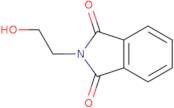N-(2-Hydroxyethyl)phthalimide
CAS: 3891-07-4
Rif. 3D-FH75345
| 1kg | Fuori produzione | ||
| 2kg | Fuori produzione | ||
| 5kg | Fuori produzione | ||
| 250g | Fuori produzione | ||
| 500g | Fuori produzione |
Informazioni sul prodotto
- 1H-Isoindole-1,3(2H)-dione, 2-(2-hydroxyethyl)-
- 2-(2-Hydroxyethyl)-1H-Isoindole-1,3(2H)-Dione
- 2-(2-Hydroxyethyl)-1H-Isoindole-3(2H)-Dione
- 2-(2-Hydroxyethyl)-2,3-dihydro-1H-isoindole-1,3-dione
- 2-(2-Hydroxyethyl)isoindole-1,3-dione
- 2-(2-Hydroxyethyl)isoindoline-1,3-dione
- 2-(N-Phthalimidyl)ethyl alcohol
- 2-Hydroxyethylphthalimide
- 2-Phthalimidoethanol
- Akos Bbs-00004429
- Vedi altri sinonimi
- N-(Beta-Hydroxyethyl)Phthalimide
- N-Hydroxyethylphthalimide
- N-hydroethyl phthalimide
- NSC 2773
- NSC 50624
- Phthalimide, N-(2-hydroxyethyl)-
- Timtec-Bb Sbb003638
N-(2-Hydroxyethyl)phthalimide is an alkylating agent that reacts with nucleophiles to form covalent bonds. It is used as a growth regulator in agriculture, primarily for cereal crops, and also has been shown to have some antifungal properties. It binds to the antigenic site on the surface of cells and blocks the synthesis of proteins by inhibiting DNA replication and transcription. N-(2-Hydroxyethyl)phthalimide inhibits the growth of mycobacteria such as Mycobacterium avium complex by binding to a chloride ion in their cell walls, which reduces acidity and prevents hydrolysis by esterases. The drug also enhances the activity of other drugs such as chloramphenicol or erythromycin by preventing their hydrolysis by esterases or glucuronidases. N-(2-Hydroxyethyl)phthalimide has been shown to inhibit herpes simplex virus (HSV





